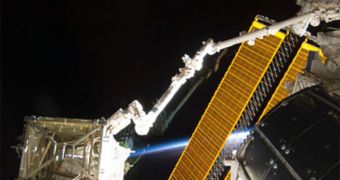On Thursday, two Discovery astronauts spent little over six hours installing the new S6 truss rod segment to the International Space Station (ISS)' starboard side. The operations began at 1:16 pm EDT (1716 GMT), and were carried out by mission specialists Steven Swanson and Richard Arnold II. With the successful completion of this crucial phase of the mission, the station is ready to deploy it's last set of solar arrays today, which means that it will be able to support an extended permanent crew of 6 astronauts, starting late May.
Even though the 16-ton segment was successfully installed yesterday, the panels themselves won't be deployed until later today. Until then, they will remain folded like maps in their storage boxes, located at the end of the ISS' new “backbone” part. This last set of US-built arrays will provide a quarter of the energy requirements for the extended crew all by itself.
The crew members handling the $298-million solar wings with the aid of both Discovery's and the ISS' robotic arms worked crammed in their NASA space suits, and managed to deliver their payload in the right place even though they had little room for error. At times, the girder neared the walls of the space station within a few inches, but, thankfully, there were no large swings to threaten the facility's hull integrity.
“It's a lot bigger than when you left it, you guys were outstanding. Thanks for the hard work,” ISS mission commander NASA astronaut Michael Fincke told the pair when they wrapped up their work. Afterwards, there was a celebration, as the Discovery crew was sure to pack a small chocolate cake with them. It was Fincke's birthday a few days ago, and the 10 astronauts currently aboard the ISS wanted to make the moment as happy for the commander as possible.
Yesterday's spacewalk was the 121st dedicated to the construction of the $100-billion orbital facility, and just the first of the three planned for Discovery until its retirement in 2010. The lab weighs now roughly 1 million pounds (453,592 kg), and is about the length of an American football stadium. Sixteen nations contributed to the project, and the scientific projects that went on inside yielded very promising results, over more than a decade of operations.

 14 DAY TRIAL //
14 DAY TRIAL //